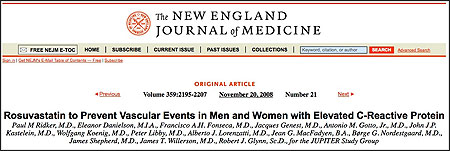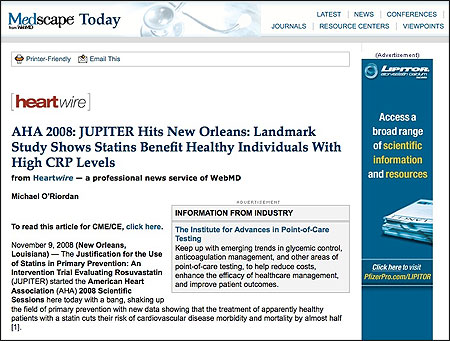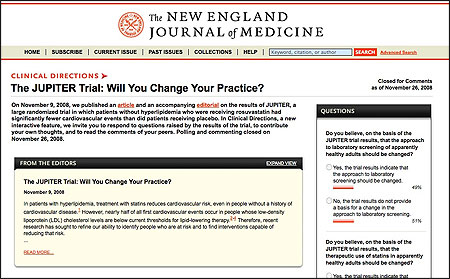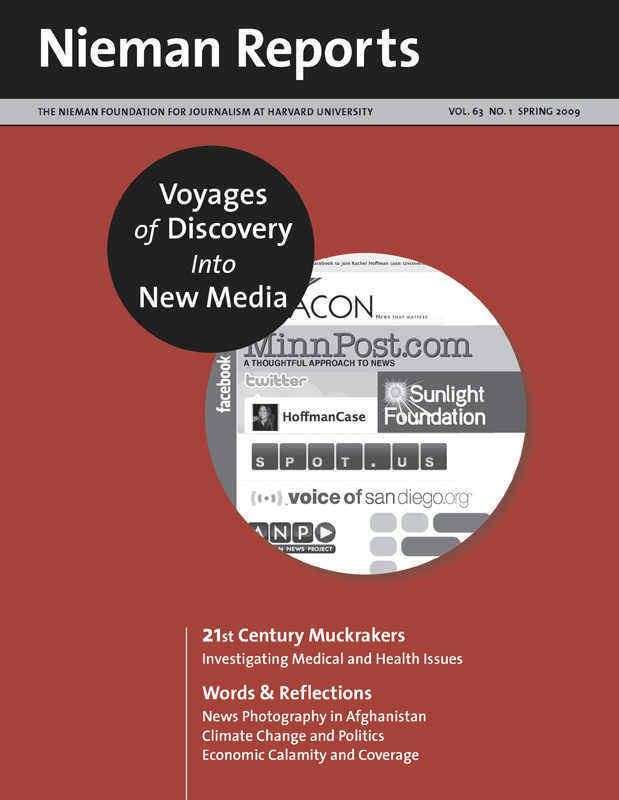
When it comes to real-time reporting on medical science, journalists (as well as many experts and even medical journals) have been largely relegated to the role of cheerleading for the industry, unable to fulfill their rightful role as critical investigators providing a balanced view. The most recent example is the reporting of the JUPITER trial, which purported to show that people with normal cholesterol but elevated C-reactive protein levels benefit from being treated with the statin drug, Crestor.
My award for the most accurate coverage of this story goes hands down to ersatz (though some—surely including himself—would say uber-)journalist Stephen Colbert, who described the study as “a great breakthrough in the battle to find things to prescribe to people who don’t need them.” The rest of the coverage trailed far behind.
The Reporting Trail
About a week before reports of the JUPITER trial blanketed the media, a staff writer for a major newspaper sought my comments on the still embargoed New England Journal of Medicine (NEJM) article about the study. The authors reported that treatment of people with normal cholesterol but elevated levels of inflammation (as measured by a C-reactive protein test) with the statin drug Crestor reduced the risk of heart attack by 54 percent, serious cardiovascular complications in toto by 47 percent, and death by 20 percent. The article concluded that:
… the rates of a first major cardiovascular event and death from any cause were significantly reduced among the participants who received [Crestor] as compared with those who received placebo.
Clearly this story was going to have enormous impact on preventive medical care. I asked the writer if I could share the embargoed NEJM article with my colleague Jim Wright, who holds a medical and doctorate degree and is the managing director of the Therapeutics Initiative at The University of British Columbia, arguably one of the best centers for critical drug research in the world. Jim and I reviewed the NEJM article individually and together and arrived at a very different overall impression of the import of the study’s actual findings. We then presented our analysis to the journalist in a conference call.
Yes, there were significantly fewer serious cardiovascular events in the people treated with Crestor. But in terms of the actual benefit, 170 people had to be treated for a year to prevent one event at a cost of $270,000 for the Crestor alone. This dollar figure did not include the cost of screening many more people with a C-reactive protein test and the extra doctor visits and lab work to make sure there were no adverse effects of treatment with Crestor.
Nonetheless, fewer people with cardiovascular disease meant fewer people requiring expensive treatment and therefore savings, right? Wrong: The more important finding—which got short shrift in the NEJM article and none in the media coverage that followed—was that there was no difference in the overall rate of serious illnesses (called “serious adverse events”) that occurred in the Crestor and placebo groups. In other words, there weren’t fewer sick people requiring hospital treatment in the Crestor group (they just had different kinds of serious illness), and therefore the savings realized on less cardiovascular care would be used taking care of other illnesses.
There was also the finding that more people taking Crestor developed diabetes, which would not have been included in the “serious adverse event” category because rarely does an adult who develops diabetes require hospitalization.
The 20 percent lower death rate among people treated with Crestor was certainly noteworthy. However, a closer look showed that 400 people had to be treated with Crestor for a year to prevent one death, at a cost of about $580,000 for the drugs alone, not including all of the blood tests and doctor visits that would be necessary to treat all 400 people with Crestor.
But there was an even more troubling ethical and scientific problem with the study. The people in the study were hypothesized to be at increased risk of heart disease because of their elevated C-reactive protein levels. In addition, 41 percent had metabolic syndrome (a complex of risk factors that derive largely from being overweight and underactive), and 15 percent smoked cigarettes. Without doubt, the best way for these people to decrease their risk of heart disease is to make positive changes in their lifestyle—routinely exercise, eat a healthy diet without unnecessary calories, and stop smoking. Previous randomized trials have also shown that participation in comprehensive lifestyle modification programs significantly decreases the risk of cardiovascular disease as well as diabetes. But counseling on the importance of healthy lifestyle changes wasn’t even included in the study protocol.
So not including lifestyle counseling for everyone in the study wasn’t just an ethical breach (withholding optimal therapy in the context of a clinical trial) but it was a scientific breach (at best the results showed what happens when people with elevated C-reactive protein levels are provided with substandard medical care).
We discussed these issues at length with the reporter but to no avail. When published, his article, like the others in major newspapers, did not address the fact that there was no decrease in serious illness overall or that optimal therapy had been withheld. Instead the breakthrough nature of the study was universally proclaimed.

What Got Published
What follows is a sampling of what major newspapers reported about the JUPITER trial:
The New York Times opened its front-page story with “A large new study suggests that millions more people could benefit from taking the cholesterol-lowering drugs known as statins, even if they have low cholesterol, because the drugs can significantly lower their risk of heart attacks, strokes and death.”
The Wall Street Journal and Los Angeles Times reported that “an eagerly anticipated study … found that statin drugs … can halve the risk of heart attacks and stroke in seemingly healthy patients as well.”Page One coverage in The Washington Post had a similarly enthusiastic opening: “A highly anticipated study has produced powerful evidence that a simple blood test can spot seemingly healthy people who are at increased risk for a heart attack or stroke and that giving them a widely used drug offers potent protection against the nation’s leading killers.”
Here are two examples of editorials about the study:
The Boston Globe used the headline “Breakthrough at the Brigham,” the hometown hospital where the lead author does his research, on its editorial. Then it heaped on adulation—“game-changing” and “paradigm shifting”—and concluded that Crestor’s “benefit was significant.” The New York Times editorialized: “A large new study seems to suggest that millions of people with low cholesterol could benefit from taking the cholesterol-lowering drugs known as statins. That would be a boon for some drug companies, but whether it would be good for all patients remains an open question.”
Notice the question is not whether there is any overall benefit, but whether all patients would benefit from taking a statin. (I guess, in some eyes, we’ve all become patients.)

Moving Against Message
RELATED ARTICLES
"Silenced Words: An Op-ed That Couldn’t Find a Home"
- John Abramson, Jim Wright, and Merrill Goozner
"Diving Into Data to Tell Untold Medical Stories"
- John CareyJim and I, with considerable input from Merrill Goozner, former Chicago Tribune economics correspondent and author of “The $800 Million Pill,” wrote an op-ed piece, hoping to get a fair description of the study’s results into play. But our efforts were unrequited: Our piece has the distinction of having been rejected by The New York Times, Los Angeles Times, The Washington Post, and The Wall Street Journal.
The misreporting of the JUPITER trial is by no means an isolated event. John Carey, a BusinessWeek reporter, describes in this issue of Nieman Reports the fear and trembling that he felt as a journalist challenging the sacred cow of preventive medicine—driving down cholesterol in people without heart disease. He persevered, and his award-winning cover story showed how doctors, patients and journalists were led down a faux path for years with the idea that the best way to decrease the burden of heart disease is to lower cholesterol with statins. He deserves great credit for his courage and for explaining the devil in the details with grace and simplicity: The much heralded 36 percent reduction in heart disease risk achieved by treating people who have high blood pressure and at least three other risk factors with a statin translates into needing to treat 100 such people for three years in order to prevent a single heart attack. Not such a breakthrough as we were all led to believe at the time.
AUTHOR'S NOTE
A year before Carey’s article was published, Jim Wright and I had a commentary published in The Lancet showing that the cholesterol guidelines that compel doctors to put women and people over 65 who don’t have heart disease or diabetes on statins simply and unambiguously misrepresented the results of clinical trials to justify their recommendations. Our commentary, exposing the lie of the guidelines that were and still are responsible for millions of Americans being put on statin drugs, received virtually no press coverage.Carey’s article in BusinessWeek also probably marked the beginning of the decline of the “lowering cholesterol with drugs is the best way to prevent heart disease” theory. But the hype couldn’t be exposed in real time, only through the rearview mirror, after the positive effect on marketing of statin drugs had been well established.
There’s a structural impediment to good medical reporting that needs to be illuminated: The fundamental purpose of medical science has been transformed from a public good supported primarily with public funding into a commodity produced primarily by commercial sponsorship. Eighty-five percent of the clinical trials, like the JUPITER trial, which inform doctors and the public about optimal medical care, are now funded by industry. Pharmaceutical companies own and guard the primary data from their clinical trials as proprietary information, like the recipe for Coke. And regardless of what the drug companies and their paid experts claim, the fundamental purpose of those studies is to maximize return on investment and return those profits to shareholders.
Researchers from Massachusetts General Hospital’s Department of Psychiatry found that when the authors of a study have financial relationships with the manufacturer of the drug being studied, the odds are almost five times greater that the results will come out in favor of the sponsor’s drug compared to studies of exactly the same drugs that are noncommercially sponsored. And when the authors have financial ties to the sponsor and the study is commercially sponsored, the odds of a positive outcome go up to 8.4.
The JUPITER study is an excellent case in point. It was sponsored by AstraZeneca (the maker of Crestor), the authors had financial ties with the sponsor, and the lead author is a co-owner of the patent on the test for C-reactive protein. Most of the stories about JUPITER informed readers about these conflicts, an important step in improving reporting but in no way sufficient to protect readers (including doctors) from the commercial bias that remains hidden in the details.
With great respect for an excellent journalist, Carey appears now to be looking at the results of the JUPITER trial through the windshield, not the rearview mirror. Not surprising, perhaps, since it is almost impossible to get the story right when the fundamentally commercial goals for which the study has been done are covered up with so much industry-sponsored expertise. My advice to medical journalists charged with reporting developments in clinical medicine includes these guiding principles:
- Understand that the fundamental mission of commercially sponsored clinical trials is commercial.
- Search for the ways in which the commercial objective might have trumped dispassionate science—in the study design, analysis and presentation.
- Realize that identifying the financial ties isn’t enough. Readers won’t understand the extent to which the fundamental nature of the results can be spun, as in JUPITER.
- Recognize that presenting the comments of one or two experts who don’t have financial ties to interested drug makers isn’t enough. The majority of the reflection on the import of the findings should be from nonfinancially conflicted experts.
For better or worse, good medical reporting now requires an investigative approach. Given the strained circumstances under which journalists need to report today, this approach can sound like “mission impossible,” and it might be. But readers need to know that, too.
John Abramson, trained as a primary care physician, is a clinical instructor at Harvard Medical School, author of “Overdosed America: The Broken Promise of American Medicine,” and serves as an expert consultant to plaintiffs’ attorneys in litigation involving the pharmaceutical industry.
